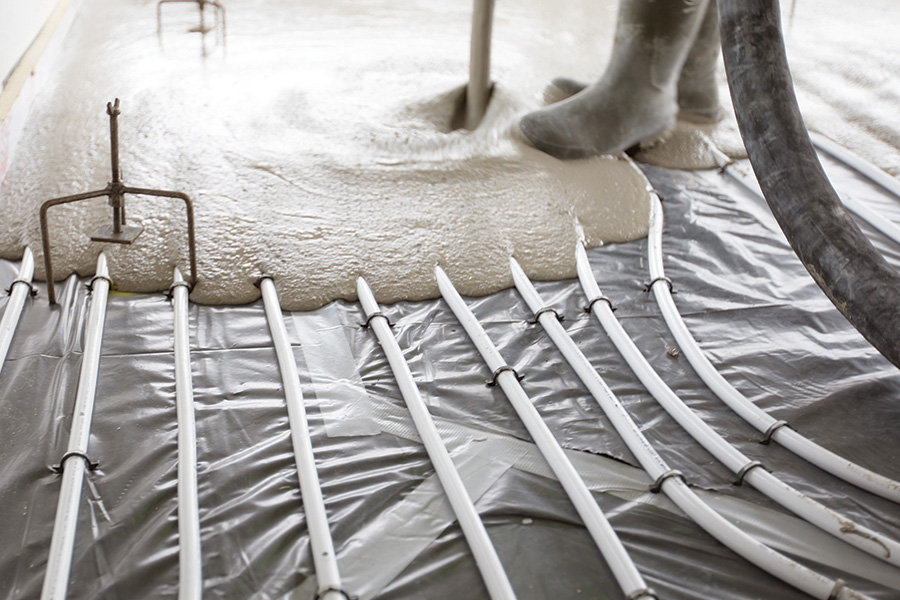The adoption of underfloor heating in the UK has recently experienced a notable increase, aligning with expectations set years ago. While most of Europe has widely embraced underfloor heating in their new construction projects, the UK has been slower to adopt this technology.
As early as 2000, the European average for underfloor heating coverage in newbuild projects, encompassing warm water systems and electric, stood at 45% of the floor area, with some countries exceeding 60%. This figure included the UK, but as our contribution was merely 3%, it affected the overall average.
Andy Vincent, specifications manager, Cemfloor Liquid Screed Solutions at McGraths Limestone, has provided the following information:
From the early 2000s onwards, the progress in the adoption of underfloor heating remained relatively stagnant for a considerable time. The growth observed during this period was modest, characterised by single-digit percentage increases in the better years, and occasional instances of no growth or even reductions.
By 2018, underfloor heating in the UK new-build market had only reached approximately 8% in terms of floor area. With hindsight however, this seems to be about the point when things started to change. The increasing interest in underfloor heating in recent years can be attributed to several factors that have encouraged its adoption.
Efforts to enhance the thermal performance of buildings for energy cost savings and improved environmental sustainability have been ongoing for some time. However, in the past five years, there’s been a notable upswing in the urgency to address these concerns. Underfloor heating has always been recognised as a more efficient heating method compared to radiators or other systems, making it a natural choice for increasing usage.
While cost and the environment have always been considered, it’s perhaps the changes required by Part L Building regulations (concerned with reducing energy consumption) that may be the biggest driver. From the end of 2025 new buildings will be required to utilise low temperature and efficient heat sources. This could mean electric systems making use of photoelectric panels as the energy source, but the more commonly known choice would be heat-pumps.
Essentially these provide low cost and ‘green’ energy by absorbing heat energy from sources like the ground, air, or water (eg lakes) and emit it to where it’s needed. This is efficient because there’s no fuel being ‘burned’ to release its energy. The only energy required is that for the movement of the heating energy from one location to another, and this is most effective when done at relatively low temperatures. Underfloor heating is the optimal choice when low-temperature sources are the only viable option. In effect, underfloor will be the only form of warm water heating that will be used in two years’ time in newbuilds.
Over the past five years, the substantial growth in underfloor heating usage has been accompanied by a notable increase in the sales of liquid applied flowing screeds. In this period, the use of flowing screeds has grown from about 15-16% of the total sq m screeded per year in the UK to about 40%.
The extreme growth of liquid screeds can partly be attributed to the arrival of such screeds based on cement whereas before there was only anhydrite flowing screeds.
This is by no means the only factor though because, during the same period, the sales of anhydrite screeds have also grown markedly. Of perhaps equal importance in this growth seems to be the increasing awareness in the marketplace of the very pronounced benefits of liquid screeds when used in conjunction with underfloor heating.
Liquid screeds can be installed at lower thickness over underfloor heating pipes – typically just over 40mm instead of the minimum 75mm that would be needed for a traditional, hand-applied screed.
If there’s less screed to heat and cool, and less thickness of screed for the heat to transmit through then this will of course help the efficiency and particularly the response times for the system. Liquid screeds also offer superior thermal conductivity, further enhancing the system performance.
The most significant advantage of using a liquid screed over an underfloor heating system is that, as a liquid, the screed material will flow around and under the pipe, fully encapsulating it. This cannot be achieved with traditional screeding methods where the material won’t be under the pipe. Effectively only about 60% of the pipe will be in contact with the screed, which is the heat conductor, so that 40% of the pipe won’t be ‘doing its job’.
With a liquid screed, 100% of the pipe will be effective.
Whatever the driving forces, it’s evident liquid screeds and underfloor heating sales seem now to be following the path taken by many other countries in previous years. Current estimates of the underfloor heating market size range from the low to high 20s as a % in terms of total newbuild floor area.
Indications suggest the impressive growth witnessed thus far will continue or even accelerate in the years to come.
www.cemfloor.co.uk
Please click to view more articles about
> Cemfloor <

